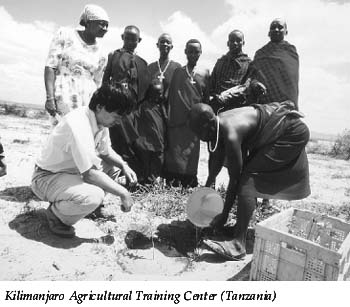
8. Project-type Technical Cooperation
Outline
The three fundamental types of technical cooperation -acceptance of trainees, dispatch of experts, and provision of equipment and materials- may be systematically and organically integrated to create a new form of technical cooperation, known as "project-type technical cooperation", giving rise to a form of technical cooperation of considerable size in both human and monetary terms.
Links with Japan's grant aid program have multiplied in recent times; for instance, by building facilities with grant aid, then employing project-type technical cooperation to operate such facilities.
 Procedure of the Project-type Technical Cooperation
Procedure of the Project-type Technical Cooperation
Implementation Method
The specific method of implementation for project-type technical cooperation involves first designating a particular location in the recipient country as an operational base (e.g., from among research institutes, specified agricultural development zones, university medical schools or other medical institutions, and educational institutions targeting small and medium business). Japan then dispatches experts, supplies equipment and materials, and accepts trainees, while the recipient country provides the land, buildings (which may be funded with Japanese grant aid), and facilities which comprise the project's operational base, secures the local counterpart personnel who will receive technical instruction from Japanese experts, and bears all operating expenses and other local costs.
Prior to the implementation of project-type technical cooperation plans, a Record of Discussions (R/D) is prepared and signed by the implementing agencies, JICA in the case of Japan and a specified government agency or affiliated institution in the recipient country. The R/D sets out such matters as a detailed implementation plan for the proposed project and the obligations of both parties, and includes a recommendation to the respective governments for the project to proceed. Under the terms of the R/D, both governments proceed to execute the project described in the document by reaching agreement on the three components of technical cooperation mentioned at the beginning of this section.
Project-type technical cooperation contributes directly to the transfer of technology to a developing country through an integrated sequence of activities over an extended period of time and on a significant scale, and, at the same time, achieves substantial success in satisfying basic human needs (BHN) in the recipient country. It therefore plays a significant role in Japanese technical cooperation programs. Recently, there has been an increase in the number of requests for this form of cooperation, and there is a tendency for the projects sought to be increasingly diverse and sophisticated.
It must be remembered, however, that project-type technical cooperation is in essence only one form of technical cooperation. Its fundamental role is the development of human resources in various development fields by means of technology transfer. In this regard, it differs quite markedly from financial cooperation, which contributes directly to the realization of development projects.
 Geographical Distribution of Major Project-Type Technical Cooperation Projects
Geographical Distribution of Major Project-Type Technical Cooperation Projects
Three Project-Type Technical Cooperation Programs
At present, the following three distinct programs are implemented under the project-type technical cooperation scheme. All involve the integration of the three components of technical cooperation: dispatch of experts, provision of equipment and materials, and acceptance of trainees in Japan.
(1) Social and Industrial Development Cooperation Program
This program targets a broad array of sectors in which to cultivate and promote specific industries, including roads and transport, electricity and communications, science and technology, volcanic erosion control, the environment, vocational training, corporate management, and computing technology. Cooperation provided under this program generally entails human resource development for technicians and instructors, research and development, improvement and development of production techniques, and school education.
Cooperation in the environmental sector has recently gained increasing prominence, illustrated by such projects as the Japan-China Friendship Environmental Conservation Center in China.
(2) Population, Public Health, and Development Cooperation Program
This program seeks to contribute to improving social welfare in developing countries by boosting standards of public health and medical care, and promoting the concept of comprehensive family planning, which is intimately linked with maternal and child health and public hygiene. It is a form of cooperation that has long attracted serious consideration by donor countries, addressing as it does basic human needs in developing countries.
Cooperation projects funded range widely from regional public health to medical research such as primary health care in Nepal, polio control in China, and control of infectious diseases in Kenya.
(3) Agriculture, Forestry and Fisheries Cooperation Program
The intention of this program is to assist the development of agriculture, forestry, and fisheries industries in developing countries, and to increase food production, raise national income levels, and boost the standard of living by improving productivity levels.
Examples of cooperation offered under this program are indeed diverse: including traditional forms such as the development and improvement of technologies in the agricultural and fisheries sectors, and the provision of production infrastructure, and other forms such as testing and research, training and dissemination of information, measures to prevent post-harvest loss of agricultural produce, pest eradication techniques, and forest conservation and development.
In the recently topical sector of tropical rainforest conservation, project-type technical cooperation has resulted in the implementation of technical instruction programs in afforestation, reforestation, and forest conservation, for instance, tropical rainforest research in Indonesia and Amazon forest research in Brazil.
As of April 1998, a total of 221 projects were underway in these three forms of project-type technical cooperation: 93 projects under the Social and Industrial Development Cooperation Program, 45 under the Population, Public Health, and Development Cooperation Program, and 83 under the Agriculture, Forestry and Fisheries Cooperation Program.

Back to Index


 Procedure of the Project-type Technical Cooperation
Procedure of the Project-type Technical Cooperation
 Geographical Distribution of Major Project-Type Technical Cooperation Projects
Geographical Distribution of Major Project-Type Technical Cooperation Projects
